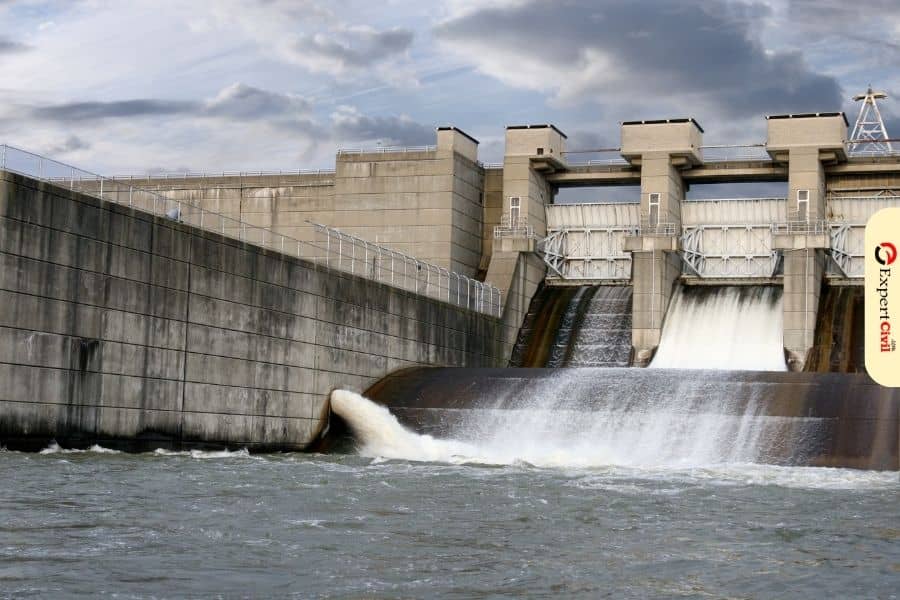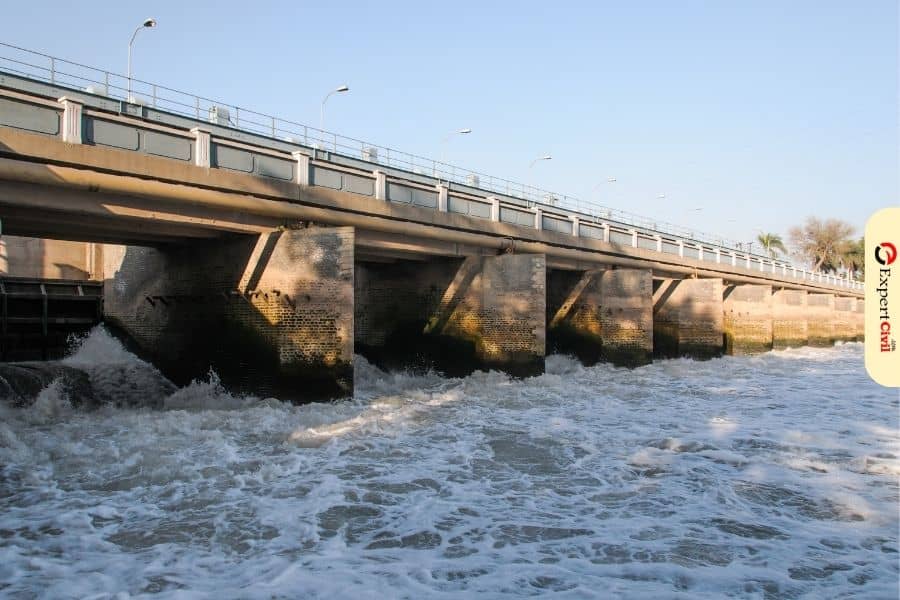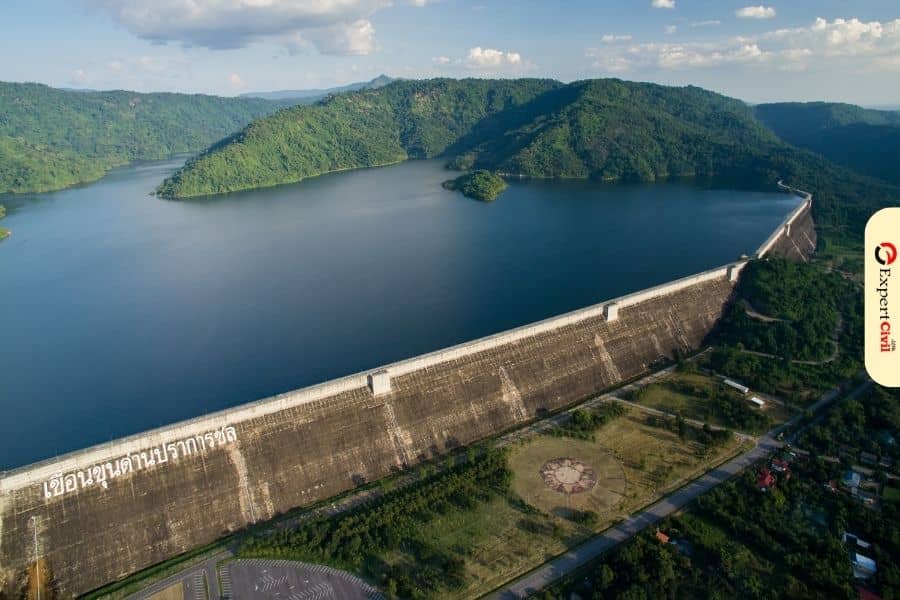What are Hydraulic Structures?
Barrage and Dam both are hydraulic structures, these structures are partially or fully submerged inside any kind of water body such as a sea, river, etc., that disrupt the natural flow of the water. These are shaped specially and are static devices that direct the water such that the free-flow conditions get specified at the point of measurement.

These structures serve multiple purposes such as diverting the water flow, storage of water, measuring the water level and flow, and many more significant purposes. Examples of hydraulic structures include Dams, Weir, Barrages, Flumes, Sluice gates, Spillways, etc.
This article is basically about the types of hydraulic structures, which are, Dams, Weir, and, barrages.
Also Read: Types of dams
Definitions:
Weir:
It’s a kind of barrier that doesn’t allow water to pass, its construction is done across the inundation river in such a way that the level of water gets raised on the upstream side and extra water gets flowed over the weir easily. It is used for making rivers navigable, measure the discharge of water, control of floods, collect water behind the wall of a weir is used for irrigation and supply of drinking water.

Barrage:
It’s an upgraded version of the weir with the installation of adjustable gates is made, operating in which the level of water gets adjusted, over the weirs to maintain the surface of the water at different times and levels. These adjustable gates get operated by cables.
It is used for making rivers navigable, measures the discharge of water, control of floods, it is made to raise the amount level of water by some feet and divert the flow of water, in this the water flow is kept stable for the intended purposes like irrigation unlike in a dam.

Dam:
It’s a structure that highly doesn’t allow the flow of water to pass, which is been constructed across the river. The major purpose of its construction is to form a reservoir with deep storage.
Its design is such that an extra amount of water can’t flow over it. Spillways are provided at designed levels from where water is allowed to flow. It is used for multiple purposes apart from water storage such as controlling floods, irrigation, production of hydroelectricity, and artistic purposes.

Difference between Barrage and Dam
| Barrage | Dam |
| It has adjustable gates, which are operated by cables. | It has gates, spillways, and sluices to allow water to flow and prevent spillage and floods. |
| This level of water gets adjusted, over the weirs in order to maintain the surface of the water at different times and levels. | It is a deep reservoir that is designed in such a way that extra water cannot flow over it. |
| It is an upgraded version of the weir with gates and a type of small dam. | It has a large and massive structure. |
| It does not store water as it is made to raise the amount level of water by some feet and to divert the flow of water. | It is made to store water. |
| It is a kind of artificial obstruction, constructed across the flow of the river. | It is used for multiple purposes apart from water storage such as controlling floods, irrigation, production of hydroelectricity, and artistic purposes. |
| It is not waterproof. | It is waterproof. |
| Its gates are located entirely on the height of the structure. | Its gates are located on top of the intake structure. |
Difference between Barrage and Dam and Weir
| Barrage | Dam | Weir |
| It is an obstruction that is artificially introduced, it is an upgraded version of a weir with gates that get operated by cables, and a type of small dam, but is constructed only to divert the water flow rather than storing or collecting the water. | It is a large, high and massive structure as compared to barrage and weirs, constructed as a deep reservoir to store water and also has many other purposes. | It is a barrier that does not allow water to pass, it is a type of low-head dam, and it is small as compared to dams, where water gets collected behind the wall. |
| It is expensive as compared to the weir. | It is more expensive as compared to barrage and weir. | It is cheaper compared to the barrage. |
| It is used for making rivers navigable, measuring the discharge of water, control of floods, it is made to raise the amount level of water by some feet and divert the flow of water, in this the water flow is kept stable for the intended purposes like irrigation unlike in a dam. | It is used for multiple purposes apart from water storage such as controlling floods, irrigation, supply of drinking water, production of hydroelectricity, and artistic purposes. | It is used for making rivers navigable, measuring the discharge of water, control of floods, collected water behind the wall of a weir is used for irrigation and supply of drinking water. |
| It is a structure made of concrete consisting of large gates in series. | It is a structure of high walls that is made of concrete and has gates, spillways, and sluices. | Materials that are used for its construction include rock mix, concrete, gravel, wood, and boulders based on age and purpose. |
| Its gates are located entirely on the height of the structure. | Its gates are located on top of the intake structure. | Its gates are downward opening overflow gates that distinct from the downward opening sluice gates |
| This level of water gets adjusted, over the weirs to maintain the surface of the water at different times and levels. | It is a deep reservoir that is designed in such a way that extra water cannot flow over it. | It’s a kind of barrier that doesn’t allow water to pass, it’s construction is done across an inundation river in such a way that the level of water gets raised on the upstream side and extra water gets flowed over the weir easily. |
| In this, the flow of water is controlled by the number of large gates which are closed or opened, allowing the structure to stabilize and regulate river water upstream. | In this, the flow of water is through the spillways and penstocks, instead of over the top of the dam. | In this, the flow of water is from upstream that runs over the top of the weir, constantly overflowing. |
Also Read: Components of Diversion Headworks


Leave a comment